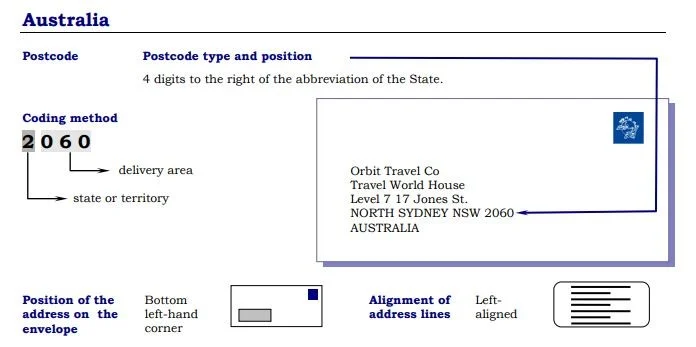 Australia Postcodes
Australia Postcodes
Discover all Postcodes in Australia across States and Localities. Instantly retrieve Australia Postcodes with interactive Postcode lookup Map.
Postcodes are a critical component of Australia's postal system, providing a structured way to organize and locate addresses across the vast expanse of the country. They play a fundamental role in facilitating efficient mail sorting and delivery, contributing to the smooth functioning of communication, commerce, and logistics nationwide. Introduced in 1967 as part of an initiative to modernize the postal system, Australian postcodes have since evolved to meet the growing demands of a rapidly changing society and economy.
To find a comprehensive list of Postcodes in Australia, please refer to the table below or click on any location on the Interactive map to instantly find the postal code and address for your mail's destination:
List of Postcodes in Australia
| State | State code | Postcodes (Range) | Count |
|---|---|---|---|
| Australian Capital Territory | ACT | 0200 to 2914 | 154 |
| New South Wales | NSW | 1001 to 4385 | 5122 |
| Northern Territory | NT | 0800 to 4825 | 364 |
| Queensland | QLD | 4000 to 9944 | 3456 |
| South Australia | SA | 0872 to 5960 | 1783 |
| Tasmania | TAS | 7000 to 7923 | 831 |
| Victoria | VIC | 3000 to 8627 | 3260 |
| Western Australia | WA | 0872 to 6997 | 1903 |
Interactive Map of Australia postcodes
Interactive Postcode lookup Map: Simply click on any location on the map to instantly reveal its Postcode and address details. For a more immersive experience, engage Fullscreen mode to maximize your exploration capabilities and enable smooth navigation with scroll gestures.
Format of Australia postcode
Australian postcodes usually have four numbers. Sometimes, they might have a letter at the end. The first number shows the state or territory. The other numbers give more details about the area. For example, postcodes in Sydney, New South Wales, often start with ‘2,’ while those in Melbourne, Victoria, may start with ‘3.’ Big users of mail services, like government departments and big companies, may have their own unique postcodes.
This format helps to sort and deliver mail efficiently. It makes sure that mail items go to the right places. By using geographic information in the postcode system, Australia Post can improve its delivery networks and give quick service to customers in different city and country areas.
History of Australia postcode
The story of Australian postcodes starts in the middle of the 20th century. At that time, the country’s postal system went through big changes. Before postcodes were introduced, sorting and delivering mail was done by hand. This was slow and inefficient, especially in crowded city areas. Australia Post saw the need for a better system. They started a project to create a postcode system that would make mail processing quicker and more accurate.
In 1967, the first postcodes were given to specific areas in big cities. This was the start of a big change for Australia’s postal infrastructure. Over time, the postcode system grew to include country and remote regions. This reflected the country’s growing population and changing geographic landscape. By the end of the 20th century, postcodes had become a part of everyday life. They were used in the addressing system and by businesses, government agencies, and people.
Implementation of Australia postcode
Putting postcodes into use in Australia needed a big effort from Australia Post, government agencies, and the public. Australia Post had a key role in creating and keeping up the postcode system. They used advanced technologies and data analytics to make sure it was accurate and effective. Government support was important in getting people to use postcodes and putting them into official address databases and mapping systems.
In recent years, technology has made the postcode system even better. Digital mapping platforms and geocoding services now let users find locations with greater accuracy. This makes it easier to use and interact with postcode data. Australia Post continues to innovate, finding new ways to use postcode information for online shopping, digital marketing, and smart city projects.
Helpful Resources:

Official website - auspost
The Official website of auspost provides comprehensive information and resources about the Postcodes system in Australia. This site allows users to search for postal codes, access forms, and find detailed guidelines on how to correctly use postal codes for efficient mail delivery within Australia.
auspost.com.au
Guidelines for Addressing Mail in Australia
This document from UPU provides comprehensive guidelines for correctly addressing mail within Australia. It includes detailed instructions on the format and positioning of the 4 Digit postcodes, recommendations for font sizes and spacing, and examples of various address formats, including those for rural areas and P.O. Boxes. The document ensures mail is properly sorted and delivered, offering practical examples for different scenarios and contact information for further assistance.
Universal Postal UnionPostcodes in Australia - Wikipedia
The Postcodes in Australia Wikipedia Page offers detailed information about the Postcodes system in Australia. This page provides historical context, the structure of postal codes, and examples of how they are used across different regions. It serves as a comprehensive resource for understanding the organization and application of postal codes within Australia.
Wikipedia
Country codes and Abbreviations - Australia (AU)
The Australia country codes Page provides Abbreviations and country codes including ISO codes, dialing codes, TLD, currency codes, time zones, neighboring countries, etc. Access essential information efficiently for streamlined referencing and exploration.
codesofcountry.comAustralia - Wikipedia
The Australia Wikipedia Page provides a comprehensive overview of the country, including its history, geography, culture, economy, and more. This page offers detailed information and is regularly updated to reflect the latest developments and insights about Australia. It serves as a valuable resource for anyone looking to learn more about Australia.
Wikipedia

